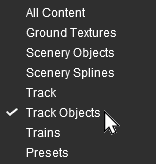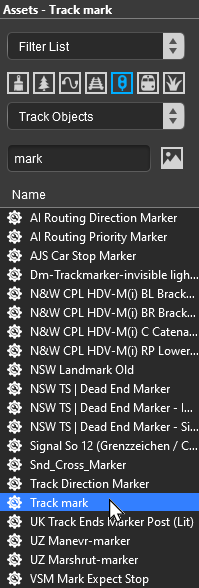How to Use S20 Tools
m (→The Placement Tool) |
m |
||
| Line 96: | Line 96: | ||
</tr> | </tr> | ||
</table> | </table> | ||
| − | The '''Brush Tool''' is used for '''painting''' the | + | The '''Brush Tool''' is used for '''painting''' the route. It can:- |
*adjust the height of the terrain | *adjust the height of the terrain | ||
*add ground textures | *add ground textures | ||
| Line 239: | Line 239: | ||
<tr valign="top"> | <tr valign="top"> | ||
<td>[[image:DotPoint.JPG|link=]]</td> | <td>[[image:DotPoint.JPG|link=]]</td> | ||
| − | <td>The <span style="font-size: 15px; font-weight: 700; color: gold; background-color: black;"> Grade </span> may cause some confusion. It is defined as '''height''' (vertical) over '''distance''' (horizontal) converted to a percentage figure. So a grade of 100% (the maximum allowed) would mean a slope formed by the height and distance being the same (e.g. a height increase of 50m over a distance of 50m). A vertical slope (a cliff) would have an infinite grade which is currently impossible in Surveyor.</td> | + | <td>The <span style="font-size: 15px; font-weight: 700; color: gold; background-color: black;"> Grade </span> may cause some confusion. It is defined as '''height''' (vertical) over '''distance''' (horizontal) converted to a percentage figure. So a grade of 100% (the maximum allowed) would mean a slope formed by the height and distance both being the same value (e.g. a height increase of 50m over a distance of 50m). A vertical slope (a cliff) would have an infinite grade which is currently impossible in Surveyor.</td> |
</tr> | </tr> | ||
</table> | </table> | ||
| Line 514: | Line 514: | ||
</tr> | </tr> | ||
<tr valign="top"> | <tr valign="top"> | ||
| − | <td colspan=3 | + | <td colspan=3>For the '''Ground Height''' feature:-</td> |
</tr> | </tr> | ||
<tr valign="top"> | <tr valign="top"> | ||
| Line 549: | Line 549: | ||
</table> | </table> | ||
| − | The '''Placement Tool''' is used to add assets to the | + | The '''Placement Tool''' is used to add assets to the route. |
| − | The first step is to identify and select | + | The first step is to identify and select the particular asset that you want to add to the route.<br> |
[[image:DotPoint1.JPG|link=]] In the '''Asset Palette''' either:- | [[image:DotPoint1.JPG|link=]] In the '''Asset Palette''' either:- | ||
| Line 686: | Line 686: | ||
<table width=1000> | <table width=1000> | ||
<tr valign="top"> | <tr valign="top"> | ||
| − | <td width=400>[[image:DotPoint5.JPG|link=]] | + | <td width=400>[[image:DotPoint5.JPG|link=]] The final step is to place the selected object into the route.<br> |
# '''Click''' the '''Placement Tool''' or press the <span style="color: white; background-color: black; font-weight: 700; font-size: 15px;"> E </span> key | # '''Click''' the '''Placement Tool''' or press the <span style="color: white; background-color: black; font-weight: 700; font-size: 15px;"> E </span> key | ||
# '''Click''' on the spot where you want to place the object</td> | # '''Click''' on the spot where you want to place the object</td> | ||
| Line 696: | Line 696: | ||
<tr valign="top"> | <tr valign="top"> | ||
<td>[[image:NotePad.PNG|link=]]</td> | <td>[[image:NotePad.PNG|link=]]</td> | ||
| − | <td>The '''Placement Tool''' will remain on and active until another tool has been selected. So everytime you click another copy of the asset (or another asset if you change your selection) will be added to the | + | <td>The '''Placement Tool''' will remain on and active until another tool has been selected. So everytime you click another copy of the asset (or another asset if you change your selection) will be added to the route.</td> |
</tr> | </tr> | ||
</table> | </table> | ||
| Line 737: | Line 737: | ||
</table> | </table> | ||
| − | The '''Eyedropper Tool''' is used to identify objects that are in the | + | The '''Eyedropper Tool''' is used to identify objects that are in the route. The objects can be textures, effect layers, scenery, rolling stock, track and track equipment, and splines. |
=='''The Free Move Tool'''== | =='''The Free Move Tool'''== | ||
| Line 748: | Line 748: | ||
</table> | </table> | ||
| − | The '''Free Move Tool''' is used to move objects in the | + | The '''Free Move Tool''' is used to move objects in the route. |
=='''The Fine Adjustment Tool'''== | =='''The Fine Adjustment Tool'''== | ||
| Line 759: | Line 759: | ||
</table> | </table> | ||
| − | The '''Fine Adjustment Tool''' is used to make fine adjustments (XYZ axis, rotation, tilt) to objects in the | + | The '''Fine Adjustment Tool''' is used to make fine adjustments (XYZ axis, rotation, tilt) to objects in the route. |
=='''The Marquee Tool'''== | =='''The Marquee Tool'''== | ||
| Line 770: | Line 770: | ||
</table> | </table> | ||
| − | The '''Marquee Tool''' is used to select areas of the | + | The '''Marquee Tool''' is used to select areas of the route. |
<table> <!-- BEGIN Nav Buttons Table --> | <table> <!-- BEGIN Nav Buttons Table --> | ||
Revision as of 13:44, 7 January 2023
The information in this Wiki Page applies to Surveyor 2.0 (S20) as found in Trainz Plus.
This document is under development
|
|
|||||||||
The Tools Palette
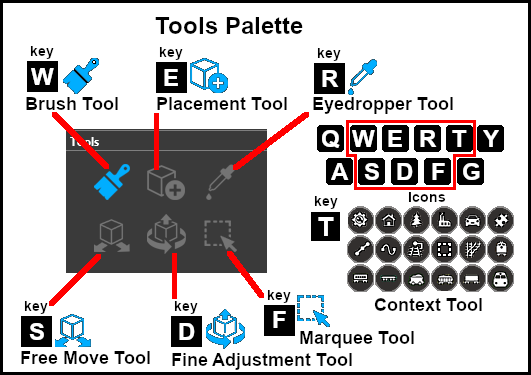 |
|
|||||||||||||||||
The Brush Tool
The Brush Tool is used for painting the route. It can:-
When selected, the Brush Tool will show two drop down menu lists. |
 |
The first drop down menu will set the Brush Target, the type of brush. The Targets are:-
|
 |
Ground Height
When this Target is selected, the second drop down box will give a choice of several Ground Height tools. The choices are:-
|
 |
| The different control options available with this brush tool are shown in the Tools Options Palette. If this palette is not visible on the screen then refer to Notes: Palettes at the top of this document. The available brush tool options are shown with a Gold coloured icon next to their names. Those options that have their icon greyed out will be ignored, but they can still be edited. |
|||||||||||||||||||||||||||||||||||
Height Up/Height Down  |
Set Height  |
Grade 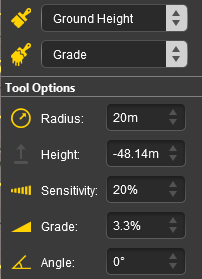 |
|
||||||||||||||||||||||||||||||||
|
Ground Texture
When this Target is selected, the second drop down box will be disabled - there are no brush texture tool choices. The different control options available with this brush tool are shown in the Tools Options Palette. If this palette is not visible on the screen then refer to Notes: Palettes at the top of this document.
The available brush tool options are shown with a Gold coloured icon next to their names. Those options that have their icon greyed out will be ignored, but they can still be edited.
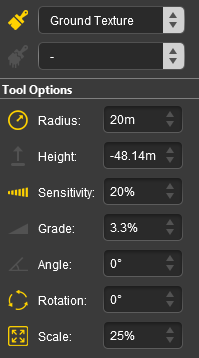 |
|
||||||||||||||||||||||||||
|
Scrapbook Data
When this Target is selected, the second drop down box will give a choice of two Scrapbook Data tools. The choices are:-
|
| The different control options available with this brush tool are shown in the Tools Options Palette. This brush tool also uses the Scrapbook Palette. If both of these palettes are not visible on the screen then refer to Notes: Palettes at the top of this document. The available brush tool options are shown with a Gold coloured icon next to their names. Those options that have their icon greyed out will be ignored, but they can still be edited. |
||||||||||||||||||||||||||
Scrapbook Clone  |
Scrapbook Brush  |
|
||||||||||||||||||||||||
|
The Srapbook Palette 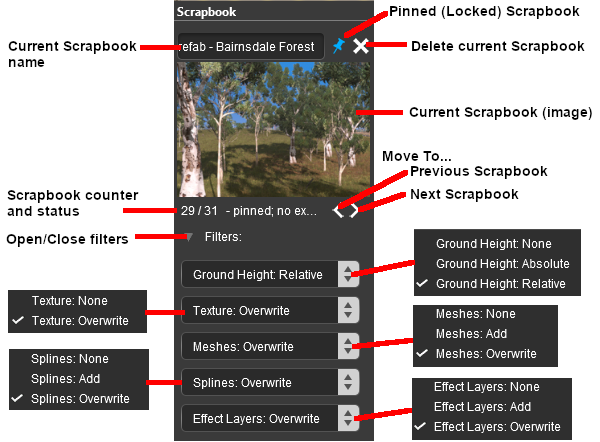 |
|
|||||||||||||||||||||||||||||||||||||||
Edit Effect Layers...
The Placement Tool
| Keyboard Shortcut: E |
The Placement Tool is used to add assets to the route.
The first step is to identify and select the particular asset that you want to add to the route.
In the Asset Palette either:-
|
OR |
|
|
|||||||||||||||||||||||||||||
|
To narrow down the filter list type part of the asset name into the Search Text Box. For example if you have selected Track Objects and want to find "Trackmarks", then type "mark" (UPPER/lower case does not matter).
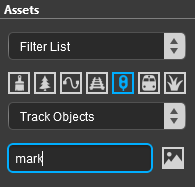 |
|
|
|
|
The Eyedropper Tool
| Keyboard Shortcut: R |
The Eyedropper Tool is used to identify objects that are in the route. The objects can be textures, effect layers, scenery, rolling stock, track and track equipment, and splines.
The Free Move Tool
| Keyboard Shortcut: S |
The Free Move Tool is used to move objects in the route.
The Fine Adjustment Tool
| Keyboard Shortcut: D |
The Fine Adjustment Tool is used to make fine adjustments (XYZ axis, rotation, tilt) to objects in the route.
The Marquee Tool
| Keyboard Shortcut: F |
The Marquee Tool is used to select areas of the route.
Trainz Wiki
 |
More Tutorials and Guides to Using Trainz |
This page was created by Trainz user pware in January 2023 and was last updated as shown below.



